The year 1723 in music involved some significant events.

Psalm 98 is the 98th psalm of the Book of Psalms, beginning in English in the King James Version: "O sing unto the Lord a new song; for he hath done marvellous things". The Book of Psalms starts the third section of the Hebrew Bible, and, as such, is a book of the Christian Old Testament. In the slightly different numbering system in the Greek Septuagint version of the Bible, and in the Latin Vulgate, this psalm is Psalm 97. In Latin, it is known as "Cantate Domino". The psalm is a hymn psalm, one of the Royal Psalms, praising God as the King of His people. Like Psalms 33 and 96, it calls for the singing of "a new song".

Psalm 149 is the 149th psalm of the Book of Psalms, a hymn as the book's penultimate piece. The first verse of the psalm calls to praise in singing, in English in the King James Version: "Sing a new song unto the Lord". Similar to Psalm 96 and Psalm 98, Psalm 149 calls to praise God in music and dance, because he has chosen his people and helped them to victory. Psalm 149 is also marked by its martial tone: it calls on the people to be ready to fight.

Johann Sebastian Bach composed the church cantata Wer Dank opfert, der preiset mich, BWV 17 in Leipzig for the fourteenth Sunday after Trinity and first performed it on 22 September 1726.

Psalm 96 is the 96th psalm of the Book of Psalms, a hymn. The first verse of the psalm calls to praise in singing, in English in the King James Version: "O sing a new song unto the Lord". Similar to Psalm 98 and Psalm 149, the psalm calls to praise God in music and dance, because he has chosen his people and helped them to victory. It is one of the royal psalms praising God as the King of His people.
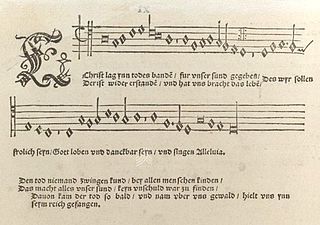
"Christ lag in Todesbanden" is an Easter hymn by Martin Luther. Its melody is by Luther and Johann Walter. Both the text and the melody were based on earlier examples. It was published in 1524 in the Erfurt Enchiridion and in Walter's choral hymnal Eyn geystlich Gesangk Buchleyn. Various composers, including Pachelbel, Bach and Telemann, have used the hymn in their compositions.

Singet dem Herrn ein neues Lied, BWV 190, is a church cantata by Johann Sebastian Bach. He wrote it in Leipzig for the New Year's Day and first performed it on 1 January 1724 as part of his first cantata cycle. He adapted it in 1730 to Singet dem Herrn ein neues Lied, BWV 190a, for the celebration of the bicentennial of the Augsburg Confession.
Gott der Hoffnung erfülle euch, TWV 1:634, BWV 218, is a church cantata by Georg Philipp Telemann formerly credited to Johann Sebastian Bach. It was composed for Whit Sunday in Eisenach in 1717, with text by Erdmann Neumeister. The closing chorale is the first stanza of Martin Luther's hymn for Pentecost "Komm, Gott Schöpfer, Heiliger Geist".
Siehe, es hat überwunden der Löwe, TWV 1:1328, BWV 219, is a church cantata by Georg Philipp Telemann, written for Michaelmas in 1723. Formerly the cantata was accredited to Johann Sebastian Bach.
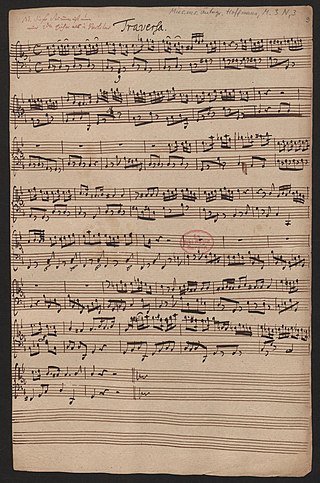
Georg Melchior Hoffmann was a Baroque composer who was influential as the leader at the Collegium Musicum in Leipzig. Some of his compositions have been mistaken for those of Johann Sebastian Bach.
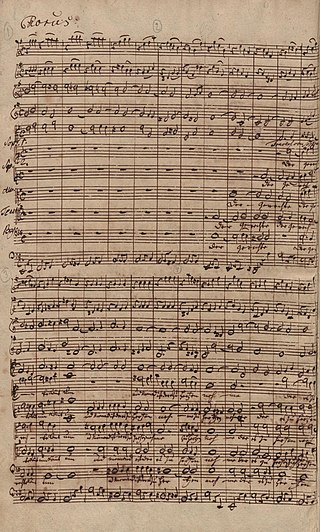
Wer ist der, so von Edom kömmt is a pasticcio Passion oratorio based on compositions by Carl Heinrich Graun, Georg Philipp Telemann, Johann Sebastian Bach and others. The pasticcio was assembled around 1750.
"Sing[e]t dem Herrn ein neues Lied" is a Lutheran hymn in four stanzas by Matthäus Apelles von Löwenstern. The text is based on Psalm 149. The hymn was first published in 1644. Löwenstern is also the composer of its hymn tune, in C major, Zahn No. 6424. Apart from this tune, the 1644 publication also contained a basso continuo accompaniment, to be performed on organ when the hymn was sung. A four-part setting of the hymn by Johann Sebastian Bach, BWV 411, was based on Löwenstern's tune. Bach's setting was first published in 1786.
Jauchzet dem Herrn alle Welt is a three-movement pasticcio motet for double SATB choir. It includes music by Georg Philipp Telemann and Johann Sebastian Bach. The text of the motet is a German paraphrase of Psalm 100.
The Telemann-Werke-Verzeichnis, abbreviated TWV, is the numbering system identifying compositions by Georg Philipp Telemann, published by musicologist Martin Ruhnke.

The Magnificat in A minor, BWV Anh. 21, TWV 1:1748, is Melchior Hoffmann's musical setting of a German version of the Song of Mary from the Gospel of Luke. The composition originated around 1707, when the composer was director musices and organist of the Neue Kirche in Leipzig. Composed in A minor, the Magnificat is scored for soprano and small orchestra. The work was first published in the 1950s, and it was recorded by Magda László, by Joshua Rifkin, by Wolfgang Helbich, and by Deborah York, among others.
Sing(e)t dem Herr(e)n ein neues Lied is German for "sing unto the Lord a new song". The German expression may refer to:
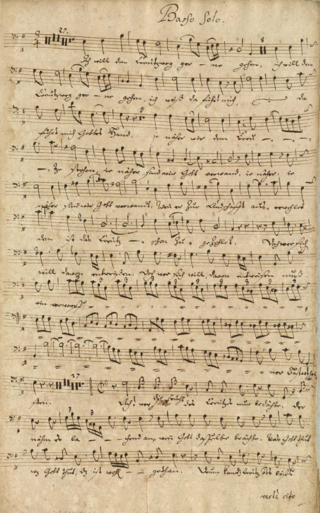
Georg Philipp Telemann composed the church cantata Ich will den Kreuzweg gerne gehen, TWV 1:884, for bass, violin and continuo for the 21st Sunday after Trinity. He used a text by Erdmann Neumeister.
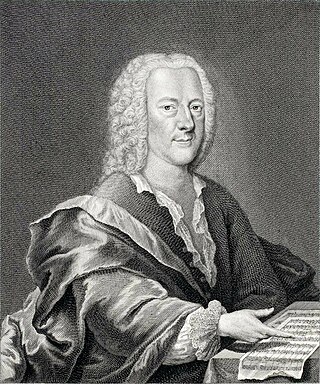
Georg Philipp Telemann composed the motet Ein feste Burg ist unser Gott, TWV 8:7, setting Luther's hymn in German, "Ein feste Burg ist unser Gott", for a four-part choir and continuo. The motet was first published around 1780. A modern edition was published by Carus-Verlag.










